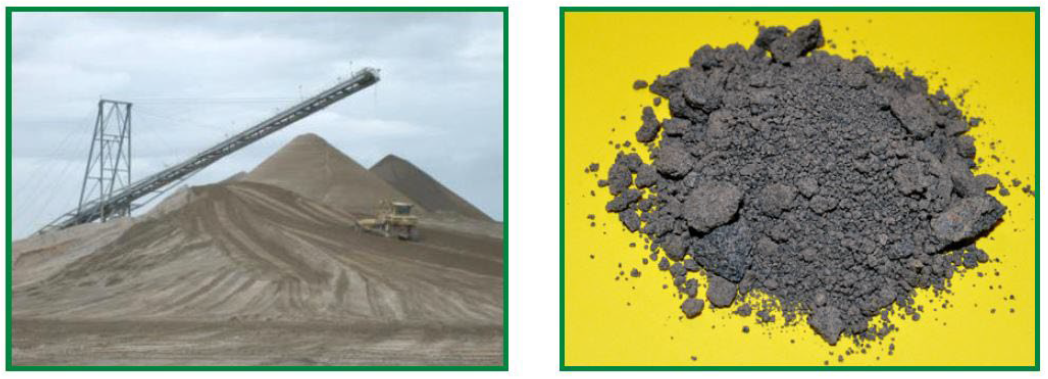⇦ Back to Fertilizer Lime Amendment Technology and Use Home
¶ Introduction
Phosphorus (P) additions are needed in most areas of the world to improve soil fertility and crop production. Direct application of unprocessed phosphate rock to soil may provide a valuable source of plant nutrients in specific conditions, but there are several factors and limitations to consider.
¶ Production
Phosphate rock is obtained from geologic deposits located around the world. Apatite, a calcium phosphate mineral, is the primary constituent of phosphate rock. It is primarily extracted from sedimentary marine deposits, a small amount from igneous sources. Most phosphate rock is recovered through surface mining, although some is extracted from underground mines.
¶ Figure 1. Phosphorus Rock

The ore is first screened and some of the impurities removed near the mine site. Most phosphate rock is used to produce soluble phosphate fertilizers, but some is used for direct application to soil. While phosphate rock can be a valuable source of phosphorus for plants, it is not always appropriate for direct application. Its suitability depends partly on naturally occurring mineral impurities, such as clay, carbonate, iron, and aluminum.
Phosphate rock contains about 33% to 36% P2O5, but has no water-soluble phosphorus. The effectiveness of phosphate rock for direct application is estimated in the laboratory by dissolving rock in a solution containing a dilute acid to simulate soil conditions. Sources classified as “highly reactive” are the most suitable for direct soil application.
Direct use of phosphate rock avoids the extra processing associated with converting apatite to a soluble form. The minimal processing may result in a lower-cost nutrient source and make it acceptable for organic crop production systems.
¶ Agricultural Use
When a water-soluble phosphorus fertilizer is added to soil, it quickly dissolves and reacts to form low solubility compounds. When phosphate rock is added to soil, it slowly dissolves to gradually release nutrients, but the rate of dissolution may be too slow to support healthy plant growth in some soils. To optimize the effectiveness of phosphate rock, these factors should be considered:
- Soil pH: phosphate rock requires acid soil conditions to be an effective nutrient source. Use of phosphate rock is not usually recommended when the soil pH exceeds 5.5. Adding lime to correct soil pH may slow phosphate rock dissolution
- Soil phosphorus fixing capacity: The dissolution of phosphate rock increases with a greater phosphorus-fixing capacity of soil (such as high clay content).
- Soil properties: Low calcium and high soil organic matter tend to speed phosphate rock dissolution.
- Placement: Broadcasting phosphate rock and incorporation with tillage speeds the reaction with the soil.
- Species: Some plant species can better utilize phosphate rock due to their excretion of organic acids from the roots into the surrounding soil.
- Timing: The lengthy dissolution time requires application in advance of plant demand.
¶ Management Practices
Not all sources of unprocessed phosphate rock are suitable for direct application to soil. Additionally, many soils are not suitable for phosphate rock use. The total phosphorus content of a material is not a good predictor of the potential reactivity in the soil. For example, many igneous phosphate rock sources are high in total phosphorus, but are of low reactivity and provide minimal plant nutrition because they dissolve so slowly. However, mycorrhizal fungi may aid in extracting phosphorus from low-solubility materials in some environments.
Over 90% of phosphate rock is converted into soluble phosphorus fertilizer through reaction with acid. This is similar to the chemical reaction that phosphate rock undergoes when it reacts with soil acidity. The agronomic and economic effectiveness of phosphate rock can be equivalent to water-soluble phosphorus fertilizers in some circumstances, but the specific conditions should be considered when making this choice.
¶ References
IPNI. Nutrient Source Specifics No. 19: Phosphate Rock. International Plant Nutrition Institute, Norcross Georgia. 1 pg.